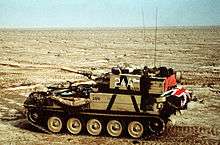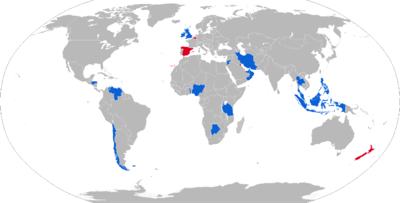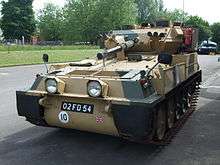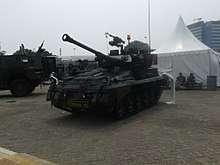FV101 Scorpion
| FV101 Scorpion | |
|---|---|
.jpg) Irish Army Scorpion CVR(T) | |
| Type | Reconnaissance vehicle |
| Place of origin | United Kingdom |
| Service history | |
| In service | 1973–present |
| Used by | Operators |
| Wars |
Iran–Iraq War[1] Falklands war Gulf war |
| Production history | |
| Manufacturer | Alvis Vehicles Ltd, Coventry, England |
| Variants | Scorpion 90 |
| Specifications | |
| Weight | 17,800 lb (8.074 tonnes) |
| Length | 5.288 m (17 ft 4.2 in)[2] |
| Width | 2.134 m (7 ft 0 in)[2] |
| Height | 2.102 m (6 ft 10.8 in)[2] |
| Crew | 3[2] |
|
| |
| Armour | Aluminium armour, Cast and 1318b plate |
Main armament |
ROF 76mm L23A1 gun 90 mm in Scorpion 90[2] |
Secondary armament | Coaxial 7.62 mm L43A1 machine gun[2] |
| Engine |
Cummins BTA 5.9-litre (diesel)[2] 190 hp (140 kW) |
| Power/weight | 22.92 hp (17.3 kW) / tonne[2] |
| Transmission | Self Change Gears TN15X[2] |
| Suspension | Torsion-bar |
Operational range | 756 km (470 mi)[2] |
| Speed | 72.5 km/h (45.0 mph)[2] |
The FV101 Scorpion is a British armoured reconnaissance vehicle. It was the lead vehicle and the fire support type in the Combat Vehicle Reconnaissance (Tracked), CVR(T), family of seven armoured vehicles. Manufactured by Alvis, it was introduced into service with the British Army in 1973 and served until 1994.[3] The base model was retired from active service, but the army retains a number of base Scorpions in reserve as training vehicles.[4] More than 3,000 were produced and used as a reconnaissance vehicle or a light tank. It holds the Guinness world record for the fastest production tank; recorded doing 82.23 km/h (51.10 mph) at the QinetiQ vehicle test track, Chertsey, Surrey, on 26 January 2002.[5]
History
The Alvis Scorpion was developed to meet a British Army requirement for the Combat Vehicle Reconnaissance (Tracked) or CVR(T). In 1967, Alvis was awarded the contract to produce 30 CVR(T) prototypes. Vehicles P1–P17 being the Scorpion prototypes were delivered on time and within the budget.[6] After extensive hot and cold weather trials in Norway, Australia, Abu Dhabi and Canada, the Scorpion was accepted by the British Army in May 1970, with a contract for 275, which later rose to 313 vehicles.[7] The first production vehicles were completed in 1972 and the first British regiment to be equipped with the Scorpion was the Blues and Royals of the Household Cavalry in 1973.[7][8]
Alvis built more than 3,000 Scorpion vehicles for the British Army, Royal Air Force Regiment and the export market. All of the CVR(T) vehicles were to be air-portable; and two Scorpions could be carried in a C130 Hercules. Another requirement of the CVR(T) project was the low ground pressure, similar to that of a soldier on foot; this would serve it well in the boggy conditions of the Falklands War.
Armament
| L23A1 gun | |
|---|---|
| Place of origin | United Kingdom |
| Service history | |
| In service | 1973–present |
| Production history | |
| Manufacturer | Royal Ordnance |
| Specifications | |
| Length | 2.157 m (7 ft 0.9 in) |
|
| |
| Calibre | 76 mm (3.0 in) |
| Rate of fire | 6 rounds per minute |
| Effective firing range | 2,200 m (2,400 yd) |
The Scorpion was armed with the low velocity 76 mm L23A1 gun, which could fire high-explosive, HESH, smoke and canister rounds. Stowage was provided for 40 or 42 rounds. A 7.62 mm coaxial machine gun (3,000 rounds carried) was also fitted, as were two multi-barreled smoke grenade dischargers, one on each side of the turret.[2] The main armament has an elevation of 35 degrees and a depression of 10 degrees; the turret has a full 360-degree traverse.[9]
Engine
The original engine was the Jaguar J60 Mk 100b 4.2-litre petrol engine,[10] which was replaced by a Cummins or Perkins diesel engine.[2] The maximum speed was about 50 miles per hour (80 km/h) and it could accelerate from nought to 30 miles per hour (48 km/h) in 16 seconds. The maximum speed on water (with the flotation screen deployed) was 3.6 mph (5.8 km/h).[11] The Irish engineering company IED replaced the existing Jaguar engine in a successful re-powering process with a Steyr M16 TCA HD engine (6-cylinder, 145 kW), making the Scorpion more powerful and more reliable in critical environments.[12]
Armour
The FV101 was a very light armoured vehicle, weighing in at a mere 8 tonnes. This meant some compromises had to be made on protection. The vehicle had at least 12.7 mm[13] of aluminium armour all around, giving it 'ballistic immunity' against small low-velocity shrapnel and standard ball rifle rounds from cartridges such as 7.62×39mm, 5.56×45mm, and 7.62×51mm, all over the front 30 deg arc. Initial manufacture of the aluminium armour resulted, after time and effects of the environment, in failure. This phenomenon was known as Stress Corrosion Cracking (SCC) and it seriously affected all early builds.
Other systems
The vehicle was fitted with a nuclear, biological, chemical protection system, image intensification sights for gunner and driver and a floatation screen.[2] A commode was located under the commander's seat, an internal water tank and a boiling vessel for cooking and heating water were also provided.[14]
Scorpion 90
The Scorpion 90 or Scorpion 2 was a version armed with the long-barrelled Cockerill Mk3 M-A1 90mm gun designed for the export market.[15]
Service history
The Scorpion was or is used by the armed forces of Belgium, Botswana, Brunei, Chile, Honduras, Iran, Indonesia, Ireland, Jordan, Malaysia, New Zealand, Nigeria, Oman, Philippines, Spain, Tanzania, Thailand, Togo, Venezuela and the United Arab Emirates.[2] Iranian army acquired 250 Scorpions in the late 1970s and a number of them are still in use after being refurbished locally as the Tosan tank. While Canada never operated the Scorpion, its original turret was married with the MOWAG Piranha I chassis to create the AVGP Cougar fire support vehicle, which was used by the Canadian Armed Forces. The Scorpion on occasion deployed to main UK airports as a measure against possible terrorist threats, e.g., Operation Marmion at Heathrow Airport in 1974.[16] Similar operations in 2003 used the then-current Scimitar.
Combat use

Two troops from B Squadron, Blues and Royals served in the Falklands War. One troop was equipped with four Scorpions, the other with four FV107 Scimitars. These were the only armoured vehicles used in action by the British Army during the conflict.[17] Scorpions also served in the Gulf War. The 1st The Queen's Dragoon Guards, a reconnaissance regiment, had 32 and the close reconnaissance troops of the armoured regiments each had eight.[18] They were also used by 1 Squadron RAF Regiment, which was attached to the 1st British Armoured Division.
Foreign users
Some small armies, such as the Botswana Defence Force and the Irish Army, and notably the larger Philippine Army and Nigerian Army continue to use the Scorpion, in some cases up-armed with the 90 mm Cockerill.
The Iranian army used its Scorpion tanks in the Iran–Iraq War, with various degrees of success. Early in the war, Iranians used the Scorpions's "accurate fire" (alongside the Cobra attack helicopters) to hold back Iraqi 2nd Infrantry Division's offensive towards the city of Ilam.[1] However, the Scorpions proved less effective when faced with Iraq's 9th Armoured Division:[1]
A second [Iraqi] column rushed to Susangerd, which it crossed without encountering any resistance, the city having apparently been left defenseless. The column continued in the direction of Hamidiyeh. It came into contact with the [Iranian] 92nd Armored Division's reconnaissance regiment, which met it with effective in-depth defense. Yet the Iranians eventually had to yield in the face of Iraqi pressure. Their Scorpions' 90 mm guns did not hold their weight against the T-62 tanks' 115 mm guns. The Iraqis thus took control of Hamidiyeh, then Bozorg.
The British government provided Iran (and Iraq) with limited parts for their Scorpions during the war:[1]
Regarding military matters, the British government imposed two strict rules: contracts signed before the war would be honored, but the sale of equipment likely to significantly increase either side's military capacities was banned. Interpreting these regulations loosely, the British government delivered both the Iranians and the Iraqis motors and spare parts for Chieftain and Scorpion tanks, which would allow the former to maintain tanks acquired under the Shah and the latter to repair tanks captured from the Iranian army.
Sabre
The Scorpion has been withdrawn from British Army service and the refurbished hulls have been mated with surplus turrets from the FV 721 Fox CVR(W) wheeled reconnaissance vehicle to form a composite vehicle—the Sabre reconnaissance vehicle.[19]
Salamander
A small number of converted Scorpions are in use at British Army Training Unit Suffield in Canada as part of OPFOR. With the main armament barrel replaced with a dummy they represent 125mm gun armed T-80-type vehicles.
Operators


Current operators
- 1,500 units.
- 60 units.
- 16 units.
- 30 units; in service with the Chilean Marines Corps.
- 19 units.
 Indonesian FV 101 Scorpion on IIMS 2014
Indonesian FV 101 Scorpion on IIMS 2014
- 130 units.
- 90 units.
- 14 units.
- 80 units.
- 26 units.
- 150 units.
- 120 Units.
- 65 units.
- 128 units.
- 40 units.
- 12 units. Including one FV-106 Samson, one FV-104 Samaritan and one Fv-105 Sultan.
- 76 Units.
- 78 Scorpion 90, 4 or 6 FV-104 Samaritan, 2 FV-105 Sultan and 4 FV-106 Samson.[2]
Former operators
- 701 units (this total consists of all seven variants of the CVR(T)).
- Limited number captured from Iran during Iran–Iraq War[20]
- Unknown.
- 17 units on service until 2009 on the Spanish Navy, (Infantería de Marina Española). Sold to Chile. There are a couple of units on static display as of 2011.
See also

- Combat Vehicle Reconnaissance (Wheeled)
- Other CVR(T) vehicles
- FV102 Striker anti-tank guided weapon carrier
- FV103 Spartan armoured personnel carrier[21]
- FV104 Samaritan armoured ambulance[21]
- FV105 Sultan command post vehicle[21]
- FV106 Samson armoured recovery vehicle[21]
- FV107 Scimitar armoured reconnaissance vehicle[22]
- Sabre – Scorpion chassis retro-fitted with a turret from the Fox Armoured Reconnaissance Vehicle
- Alvis Stormer – a larger development of the CVR(T) used in the case of the British Army to carry the Starstreak High Velocity Missile system[23] and the Shielder minelaying system.[24]
- AVGP Cougar Canadian wheeled armoured vehicle fitted with the turret from a Scorpion.[25]
- Medium Reconnaissance Vehicle (MRV) an Australian M113A1 fitted with the turret from a Scorpion.
- Tosan, Iranian-built development of Scorpions supplied to Iran in the 1970s, carrying a 90mm gun and Toophan ATGM
Notes
- 1 2 3 4 Razoux, 2015
- 1 2 3 4 5 6 7 8 9 10 11 12 13 14 15 16 "Scorpion". Jane's Information Group. Retrieved 2009-01-11.
- ↑ https://publications.parliament.uk/pa/cm200506/cmhansrd/vo060704/text/60704w0003.htm#06070447001554
|chapter-url=missing title (help). Parliamentary Debates (Hansard). House of Commons. 4 July 2006. col. 912W–913W. - ↑ "FV101 Scorpion: Keeping the Light Tank Relevant | HistoryNet". www.historynet.com. Retrieved 2018-03-17.
- ↑ "Fastest tank". Guinnessworldrecords.com. 2002-03-26. Retrieved 2014-05-31.
- ↑ Foss & Sarson, p. 9
- 1 2 Foss & Sarson, p. 10
- ↑ Foss & Sarson, p. 4
- ↑ Foss & Sarson, p. 14
- ↑ Christopher Chant A compendium of armaments and military hardware. Retrieved 2014-05-31.
- ↑ Foss & Sarson, p. 12
- ↑ Application Gallery: Steyr-Motors.com
- ↑ Thailand Army Weapon Systems Handbook.
- ↑ Foss & Sarson, p. 11
- ↑ Foss & Sarson, p. 37
- ↑ Hughes, Geraint (2011). The Military's Role in Counterterrorism: Examples and Implications for Liberal Democracies. US Army War College, Carlisle, PA: Strategic Studies Institute. p. 91. ISBN 1584874899.
- ↑ Foss & Sarson, p. 21
- ↑ Foss & Sarson, pp. 41–44
- ↑ Foss & Sarson, p. 34
- ↑ "Former Equipment of Iraqi Army". Archive.org. Retrieved 17 July 2018.
- 1 2 3 4 "Spartan and Other CVR(T) Vehicles". MOD. Archived from the original on 2009-01-14. Retrieved 2010-01-14.
- ↑ "Scimitar Armoured Reconnaissance Vehicle". MOD. Archived from the original on 26 January 2009. Retrieved 2010-01-14.
- ↑ "Starstreak High Velocity Missile Vehicles". MOD. Archived from the original on 13 January 2009. Retrieved 2010-01-14.
- ↑ "Shielder Anti-Tank System". MOD. Archived from the original on 21 December 2008. Retrieved 2010-01-14.
- ↑ "Background – Armoured Vehicle, General Purpose – Cougar DFSV". Canadian American Strategic Review. September 2009. Archived from the original on 3 October 2009.
References
External links
| Wikimedia Commons has media related to FV101 Scorpion. |